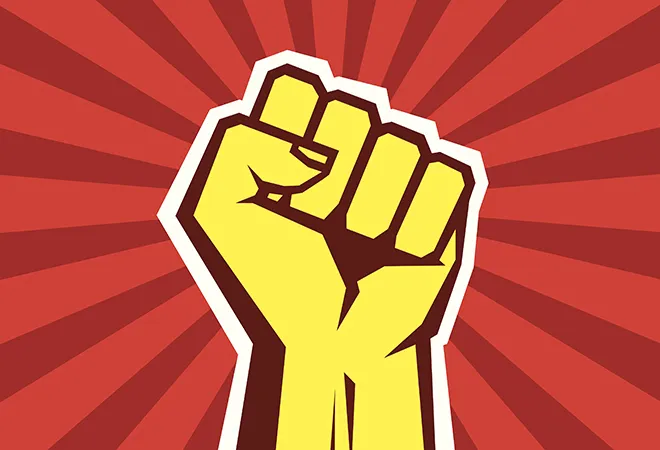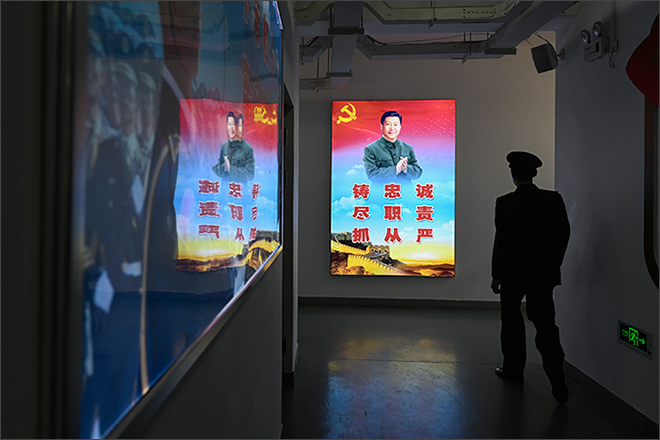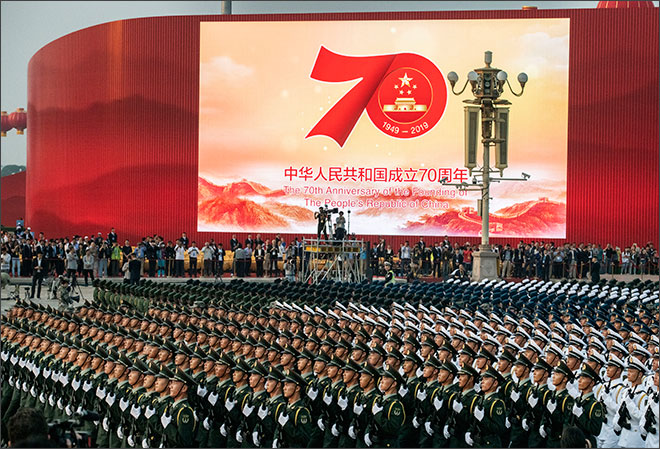
No matter what your view is of China, its leader Xi or the ruling Communist Party of China (CPC), you cannot but recognise their imprint on modern world history. Some of the things they have done are bad, very bad, but there is also a great deal of good and even spectacular.
It’s good to remember this when analysing China on the occasion of its 70th anniversary. The New York Times addressed this issue squarely when kicking off its coverage of the event from Xinyang which Xi Jinping visited recently. The Chinese leader paid tribute to the 130,000 soldiers who gave their lives for the cause and extolled China’s ‘Red Heritage.’ But had nothing to say about the one million peasants who starved to death there in the Great Famine following Mao’s Great Leap Forward.
This was, as the newspaper said, an effort to cast the tumultuous history of the People’s Republic of China as a triumphal march of 70 years. Not surprisingly, Xi’s speech on the occasion paid tribute to Mao Zedong, the founding father of the PRC and skipped over everyone else, including Deng Xiaoping, and came to the present time.
The bloodletting of the revolution and the Great Proletarian Cultural Revolution (GPCR), the disaster of the Great Leap Forward, the Great Famine, and the murky succession of Mao itself took up 30 of those 70 years.
The actual train of events, of course, have been quite tumultuous. The bloodletting of the revolution and the Great Proletarian Cultural Revolution (GPCR), the disaster of the Great Leap Forward, the Great Famine, and the murky succession of Mao itself took up 30 of those 70 years.
Conventional wisdom has it that only since Deng Xiaoping consolidated his authority that China has taken the path that has helped it virtually eliminate mass poverty and become a manufacturing powerhouse. But in the Mao years, says Keyu Jin, China modernised, “local and national power grids were established, industrial capacity was strengthened, and human capital rapidly improved.” Chinese literacy reached 66 per cent and life expectancy to 64 years by 1980. (It was 40 per cent and 54 for India and both were at approximately the same level in 1949). The reality is that despite its achievements, China is still a country, which has managed to build modest prosperity, and it knows that it can no longer rely on massive market and output growth to raise incomes.
Even as it seeks to adopt policies to promote consumption and innovation-led growth and break out of the Middle Income Trap, it is faced with internal and external challenges. Internally, it is the strengthening hand of ideology under a leader who is casting himself in the mold of Mao. This has constrained the development of a full market economy as was promised in the Third Plenum of the 18th Party Congress.
American policy is increasingly beginning to take on the appearance of a full-fledged containment of China.
Externally, China’s achievements have triggered an American pushback, which is working to deny technologies, and markets that could aid Beijing to catch up with the developed world riding on high tech innovation. Indeed, American policy is increasingly beginning to take on the appearance of a full-fledged containment of China. This will, of course, have to be preceded by a de-coupling of the US and Chinese economies, in itself a huge and messy proposition that could take down the global economic infrastructure.
On the eve of the 70th anniversary celebrations, China issued a White Paper titled “China and the World in a New Era,” which spoke of the expanding reach of “multipolarity, economic globalisation, cultural diversity and information technology.” At the same time, it said, “deep seated problems were apparent throughout the world.” Speaking of China’s achievements and its growing “comprehensive national strength” it rejected the notion that China would, like other powers “seek hegemony.” It said that no country could impose its own model on others, “let alone forcibly subvert the government and political systems of other countries.” The bottom line was that “without centralised, unified and firm leadership” China would have ‘balkanised.’ “The CPC,” it said, “is China’s core leadership, ruling the country for long and supported by the people.”
 “After coming to power, Xi launched a sweeping crackdown on corruption, punishing a galaxy of top leaders of the CPC and the PLA to consolidate his power.” Photo: Wang Zhao/Getty Images
“After coming to power, Xi launched a sweeping crackdown on corruption, punishing a galaxy of top leaders of the CPC and the PLA to consolidate his power.” Photo: Wang Zhao/Getty Images
A great deal of what China is on its 70th anniversary, has been shaped by Xi Jinping who took the reins of leadership in 2012, promising a “great rejuvenation” of the country and the fulfilment of the ‘China Dream.’ After coming to power, he launched a sweeping crackdown on corruption, punishing a galaxy of top leaders of the CPC and the PLA to consolidate his power. He has also cracked down on dissent and targeted dissidents, activists and human rights lawyers.
The PLA has been reduced in numbers and the air force and navy components of the service given greater emphasis. At the same time, the whole deployment has been rejigged in the form of theatre commands.
Today, he is the supreme leader, Chairman of the Communist Party of China and virtually everything else. He has consolidated power and has removed the term limits on his tenure as the President of the country. He was declared ‘core leader’ in 2016 giving him unprecedented authority within the Politburo Standing Committee. In 2017, the 19th Party Congress of the CPC declared that Xi’s political theory, along with that of Mao and Deng, would be the guiding principle of the party.
His biggest achievement is the reform of the military which has led to a more modern and professional force, though stacked by his loyalists. The PLA has been reduced in numbers and the air force and navy components of the service given greater emphasis. At the same time, the whole deployment has been rejigged in the form of theatre commands. Accordingly, the highlight of the 70th anniversary celebrations was, of course, the grand military parade in Beijing.
 “The highlight of the 70th anniversary celebrations was the grand military parade in Beijing.” Photo: Kevin Frayer/Getty Images
“The highlight of the 70th anniversary celebrations was the grand military parade in Beijing.” Photo: Kevin Frayer/Getty Images
The parade was an unprecedented show of power with new missiles, drones, aircraft and other equipment displayed. Among them was the DF41 ICBM, capable of hitting any part of the US with 10 independently targetable re-entry vehicles (MIRV), the DF-17 topped by hypersonic glide vehicles that can evade missiles defences and the DF 100 hypersonic cruise missile with a range of 2,000-3,000 kms. Also on display was the supersonic drone WZ8, the Sharp Sword stealth drone and a large underwater drone (UUV).
Besides the new hardware, there were many armored vehicles, gyrocopters, ship based air defence systems, SAMs, telecom and EW vehicles, hypersonic and cruise missiles, the DF26 (Guam Killer) and the JL2 submarine launched missile. Some 40 per cent of the equipment displayed was being shown for the first time. Equally impressive was the overhead fly past, which featured five J20A stealth fighters, H6 bombers, Z8 and Z10 helicopters.
It’s not what’s on display alone that worries the world, but China’s race towards becoming capable of fighting “intelligent warfare” based on its mastery of AI, quantum computing, big data and the Internet of Things (IoT).
Despite the display of weaponry, Xi’s message was inward looking, calling for the Chinese people to unite and continue to fight for the China Dream. This was underscored by his insistence that Beijing would uphold the “one country, two systems” approach to Hong Kong and Macau, though he said that the ultimate goal was “peaceful reunification.” The embattled chief executive of Hong Kong Carrie Lam witnessed the parade in Beijing, while there were reports of widespread protests in Hong Kong itself.
The views expressed above belong to the author(s). ORF research and analyses now available on Telegram! Click here to access our curated content — blogs, longforms and interviews.




 “After coming to power, Xi launched a sweeping crackdown on corruption, punishing a galaxy of top leaders of the CPC and the PLA to consolidate his power.” Photo: Wang Zhao/Getty Images
“After coming to power, Xi launched a sweeping crackdown on corruption, punishing a galaxy of top leaders of the CPC and the PLA to consolidate his power.” Photo: Wang Zhao/Getty Images “The highlight of the 70th anniversary celebrations was the grand military parade in Beijing.” Photo: Kevin Frayer/Getty Images
“The highlight of the 70th anniversary celebrations was the grand military parade in Beijing.” Photo: Kevin Frayer/Getty Images PREV
PREV


